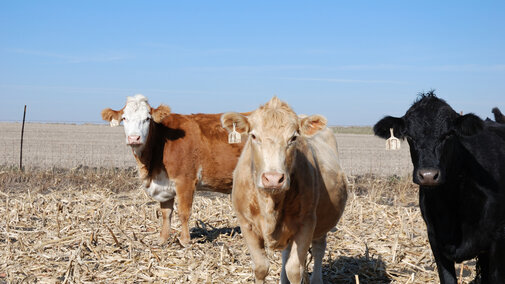Winter Annual Forages
Are you planting or at least thinking about planting wheat, rye or triticale for forage next spring? Which of these small grains should you plant this fall? Let’s look at some of their characteristics to help you select.
Cereal rye is your best choice for the earliest grazing possible. Because it’s early, it also may be the best match for double cropping. Some varieties provide quite a bit of fall growth too, if planted early. Rye also may be the most reliable when planted under stressful conditions. However, it has some drawbacks — it turns stemmy and matures much earlier than wheat or triticale, losing feed value and palatability earlier in the spring. Plus, wheat grain producers don’t want it contaminating fields next year.
Triticale holds onto its feed value best into late spring. This makes it well-suited for hay and silage, or for stretching grazing well into June if you don’t mind starting two or three weeks later compared to rye. But triticale tends to be a bit more susceptible to winter injury.
Winter wheat has been the small grain of choice for winter and spring grazing in the southern Plains where higher winter temperatures allow growth to continue, although slowly. Up here where wheat goes dormant, its carrying capacity is not as high as triticale or rye. But it is top quality before stems develop. And it’s the clear choice if you want the double use as early pasture and then for grain.
So, there it is. Rye for early pasture, triticale for hay, silage or later grazing, and wheat for grazing plus grain. You may have other factors affecting your choice, but in general, these guidelines work well.
Late Summer Pasture Weeds
Late summer always seems to be a time when weeds can become quite noticeable in pastures. Are you prepared to handle this late summer nuisance?
Perennial weeds like western ragweed, ironweed and verbena, as well as annual weeds like horseweed, sunflowers, snow-on-the-mountain and buffalo bur can be plentiful in some pastures. In areas of pastures that have relatively thin grass stands, in areas where animals congregate or if some overgrazing has occurred, they can be very visible.
Spraying weeds now does little good. Many weeds are too large to kill. On both annual and perennial species that produce seed, herbicides might only reduce some seed production. If the goal is to improve appearance, shredding areas that have an abundance of weeds might actually be the best option, and may reduce some seed production too, if it’s not already too late.
Two other approaches are better for long-term weed control. First, focus on the grazing management of your pastures. This includes using the proper stocking rate and developing a good rotational grazing plan. An important objective is to increase the health, vigor and density of your grass. Healthy, competitive grass stands are essential to reduce weed populations economically over time.
Second, target herbicide applications for when they will do the most good. Both perennial and annual species can be better targeted with a spring application when plants are smaller and able to be controlled. For perennials, if a second application is needed, waiting closer to a killing frost is best. This provides the double whammy of stressing the plant heading into winter and allows more product to be translocated down to the shoots and roots as nutrients are pulled down for winter storage. Getting a good identification on your problem weeds is crucial when making these application timing decisions.
Pasture weeds may look unsightly now but hold off on spraying. Improve grazing management and time herbicides for the best window of control so herbicides won’t be needed as often in the future.
Grazing High Nitrate Cornstalks
Extended drought is challenging livestock producers to carefully manage their fall cornstalks grazing. High nitrate levels may be not only in rainfed (dryland) fields, but also in pivot corners or field edges where plants have been severely moisture stressed.
As row crop harvest begins, wheat and rye forages may be interseeded into potentially higher nitrate cornstalks. If these late-seeded forages receive enough moisture for good fall grazing, can these forages and stalks be co-grazed safely?
Even high nitrate forages can be utilized if the livestock are stepped up on their exposure to consuming higher nitrate feeds.
First, don’t turn cattle into drought-stressed cornstalks when they are hungry. For example, feed lower nitrate forages earlier in the day until the animals become full, then provide access to the higher nitrate cornstalks later in the day.
Second, collect stalk samples from potential high nitrate “hot spot” zones and test for nitrogen levels. If the levels exceed 6,000 ppm nitrate, it may be wise to fence out pivot corners, field edges or zones where the stress is severe.
Generally, cattle prefer grazing corn leaves and husk, which usually are lower in nitrate than the lower one-third of plant stalks. So, resist the temptation to force the livestock to consume higher nitrate stalks after the leaves and husk have been gleaned.
Finally, when possible, creatively step-up cattle on grazing high nitrate feed over seven to 10 days and utilize electric fence. Then, progressively provide increased access to higher nitrate forages while allowing free choice lower nitrate, baled alternative forages. Gradually over time, the rumen microbes can adjust to higher nitrate content. In some cases, nitrate levels that might have caused death with a one-time feeding might be tolerated if introduced into the grazing system over two to three weeks.
More information on safely grazing stalks is available on UNL BeefWatch and CropWatch.

